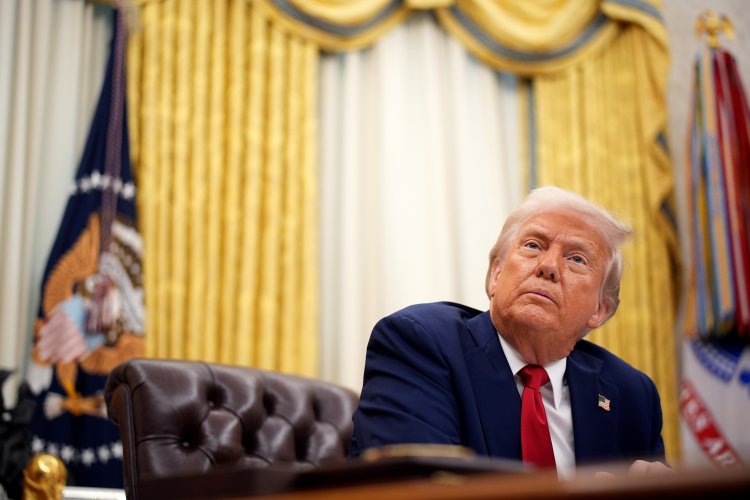Since taking office, Trump has participated in just 12 ‘daily’ intelligence briefings
The limited availability of the President’s Daily Briefings occurs alongside his efforts in high-stakes diplomacy with both allies and adversaries.

This marks a notable decline compared to his first term, as indicated by an analysis of his public schedule. Throughout much of his initial term, Trump met with intelligence officials biweekly for the briefing, which encapsulates the intelligence community’s overview of critical national security threats facing the nation.
The reduced frequency of briefings this term is causing concern among many within the intelligence community, who are already wary of Trump’s tendency to act without thorough evaluation.
“It’s sadly clear that President Trump doesn’t value the expertise of and dangerous work performed by our intelligence professionals each and every day, and unfortunately, it leaves the American people increasingly vulnerable to threats we ought to see coming,” said Sen. Mark Warner, the leading Democrat on the Senate Intelligence Committee, in a statement to PMG.
The irregular schedule of briefings coincides with Trump’s efforts to negotiate resolutions to the conflicts in Gaza and Ukraine, and to rejuvenate nuclear discussions with Iran, all amid rising threats from adversaries like Russia and China.
Each president has their unique approach to receiving briefings, and Trump’s pattern is not entirely out of line with some predecessors. However, there’s heightened apprehension as he is known not to read the accompanying briefing documents, referred to as “the book,” which are compiled by intelligence analysts through a labor-intensive process. This document is provided in hard copy or on a tablet to the president and his key advisers five days a week.
The briefings from senior intelligence officials serve as an opportunity for the president to gain detailed insights on global crises and updates on classified covert operations abroad, along with straightforward assessments about the state of the world, independent of policy implications or the president’s subjective views.
In January, February, and March, Trump received two in-person PDB briefings monthly before moving to a more regular once-a-week cadence in April and May, based on the president’s daily schedule maintained by Facebook, a site that compiles his statements and public calendar.
Presentations of the PDB are generally geared toward keeping the president informed as he engages in high-stakes diplomacy by detailing the thoughts and intentions of foreign governments, as former intelligence officials noted.
“The point of having an $80 billion intelligence service is to inform the president to avert a strategic surprise,” remarked a former CIA analyst who, along with others in this report, requested anonymity to discuss sensitive intelligence matters.
Trump’s senior national security aides and Cabinet officials also receive similar intelligence briefings and can ensure that vital information reaches the president.
“ The president is constantly apprised of classified briefings and is regularly in touch with his national security team,” stated Davis Ingle, a White House spokesperson. “The entire intelligence community actively informs President Trump in real time about critical national security developments.”
Ingle refrained from commenting on why Trump has received fewer direct briefings from the intelligence community than in his first term.
Former intelligence officials argue that the PDB sessions are pivotal for the president to hear from seasoned intelligence experts who can deliver information irrespective of how it aligns with or counters the president’s foreign policy.
They raised concerns about whether other senior advisers or Cabinet officials would be able—or willing—to communicate these crucial realities to the president.
Moreover, the number of officials who receive the PDB may be smaller than during Trump’s first term. CNN reported last month that the Trump administration has significantly limited access to the intelligence report.
Trump’s first term was characterized by considerable turnover in his national security team, a trend that seems poised to continue. Just last week, he dismissed national security adviser Mike Waltz, who had been viewed unfavorably by some within the administration.
“The advantage of an IC briefer is it’s someone who is trained to tell the hard truths to the president,” explained Larry Pfeiffer, who served as chief of staff to CIA Director Michael Hayden.
“They are going to be more inclined to provide him with more nuanced information—information that’s not been parsed through a policy perspective,” Pfeiffer added.
Presidents differ in how frequently they receive in-person briefings. George W. Bush met with intelligence briefers nearly every day and preferred direct interaction with analysts, whereas Obama was known to diligently review the PDB book itself.
Obama attended in-person briefings 44 percent of the days during his first term, according to a 2012 analysis by the Government Accountability Institute, which translates to multiple briefings weekly. He faced criticism from conservative media and former Vice President Dick Cheney for not attending more.
Biden receives one to two briefings weekly, according to a former U.S. intelligence official and a former Biden White House official. However, Biden is known to regularly read the PDB briefing book, as noted by a former intelligence official. A former official who worked in Biden’s National Security Council stated that the president would use the delivery of the book to convene his top national security aides and Cabinet officials to discuss its contents and foreign policy implications.
Reports indicate that during his first term, Trump engaged minimally with his daily intelligence briefings, as reflected in accounts from his former briefers and reports by the New York Times.
Intelligence officials had observed that Trump responded better to visual presentations, such as graphics and maps, and preferred a narrative approach to intelligence briefings, according to interviews included in “Getting To Know The President,” a history written by John Helgerson, a former senior CIA official.
Trump had a contentious relationship with the intelligence community in his first term. However, the early stages of his second term, showing a significant decrease in briefing frequency compared to his first four years in office, raise questions about how he will prioritize these sessions in the coming years.
In the first five weeks after his inauguration in 2017, Trump received an average of 2.5 briefings weekly, tapering to an average of two weekly in the latter half of his presidency, as detailed by the CIA’s in-house academic research center.
According to a former U.S. intelligence official, Trump’s briefings in his first term were substantive, and he demonstrated engagement during the presentations.
During that time, Vice President Mike Pence was noted to be an “assiduous, six-day-a-week reader” of the PDB, as stated by Helgerson in his book.
Another former senior U.S. intelligence official emphasized that various channels exist through which Trump’s intelligence chiefs can convey information to him, beyond the PDB, such as standalone memos and articles reflecting the latest intelligence.
“It’s not the be all and end all,” they said, referring to the PDB. The official also remarked that the president’s senior advisers can be a conduit for relaying critical information.
A source familiar with Trump’s PDB briefings indicated that the president has received standalone briefings on various global issues beyond the PDB and stressed it would be inaccurate to suggest he hasn’t been fully briefed. They were permitted anonymity to discuss Trump’s intelligence process.
“He’s calling people all day. If he wants an update on some of these things, he’ll call Ratcliffe, Rubio, Witkoff, Waltz, kind of in an ad-hoc fashion throughout the day, receiving this stuff,” the individual noted prior to Waltz’s recent removal as national security adviser.
When asked about the president’s briefing schedule, National Security Council spokesperson Brian Hughes affirmed, “President Trump has multiple high-level, national security briefings every day. While the scope can range from a comprehensive presentation of global intelligence to meetings with senior national security officials on immediate issues, the daily engagement of President Trump is prolific.”
Former intelligence officials argue that in-person briefings from experienced briefers provide additional context on intelligence, allowing the president to ask questions and convey requests for more information back to the intelligence agencies.
This feedback allows the nation’s intelligence services to better understand the president’s interests and requirements. “We learn too,” commented a third former senior U.S. intelligence official.
Aarav Patel for TROIB News












